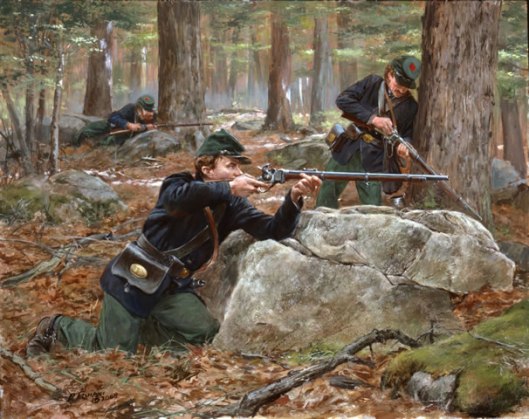
Berdan’s SharpShooter
The introduction of rifled barrels and breech-loaded weapons led to another development in the Civil War: the use of sharpshooters. Many people considered sharpshooting, or sniping, to be beneath the dignity of a civilized society. The harsh conditions of war soon removed that stigma. Almost immediately, sharpshooters became important members of every Union army in the Eastern Theater of Operations. The psychological impact on the Confederate troops was powerful. No longer was it safe for a soldier to expose himself to the enemy, even at a distance of several hundred yards. Sharpshooters changed war for the soldier on the line.
The 1st and 2nd United States Volunteer Sharpshooter Regiments or USSS (U. S. Sharps Shooters) became the best known sharpshooter units of the war. Hiram Berdan, reportedly the most accurate amateur shooter of his day, formed and trained the USSS. Qualifying recruits had to fire from 200 yards (183 meters) and place 10 consecutive shots within a 10-inch (25-centimeter) bulls-eye. Unlike other Northern units, Berdan’s men came from all across the Union. Although some Federal sharpshooters used their own weapons or other preferred gun, most usually carried Sharps rifles, breechloaders designed by a man named Christian Sharps. The success of these men in the field led to the term sharpshooter, an adaptation of “Sharps shooters.” Confederate sharpshooters usually carried British made Whitworth rifles, earning them the nickname Whitworth’s sharpshooters.
Well equipped and superbly trained, these units served as scouts at the front of advancing columns. Union sharpshooters wore green uniforms and nonreflective hard rubber buttons made by Charles Goodyear. Sharpshooters usually were the first to engage the enemy, acting as skirmishers rather than as snipers. Commanders usually tried to minimize the losses to this group of specially trained soldiers. Thus, sharpshooters performed scout and skirmishing duties but rarely participated in the large-scale assaults of defensive positions in which casualty rates usually were high.
The Confederates formed their own unit of sharpshooters in 1862. Over time, both sides eventually found that regiments of sharpshooters were too large to use effectively. Instead, sharpshooters were organized into companies. Commanders assigned these specialized companies to regiments, to serve at the will of the field general. This allowed battlefield commanders to make the best use of their sharpshooters. Commanders usually protected their sharpshooter companies by relieving them of all picket (guard) duty as well as by holding them in reserve during frontal assaults.
In 1862 Lee’s Army of Northern Virginia ran a series of tests on all the arms in general issue in the ANV. They were tested for accuracy at all ranges out to 1,000 yards. What was learned that out to approximately 500 yards all rifles and rifle-muskets were more or less equally accurate. Past 500 yards their accuracy dropped off. However, they found that the P-58 Enfield Naval Rifle and the P-60 Army Short Rifle-when fired with British made Enfield ammo was accurate out to 900/1,000 yards.
Lee’s Army of Northern Virginia organized “Sharpshooter Battalions.” These men were much more than just “sharpshooters,” but in effect, specialized (and for the Civil War) highly trained troops. They received advanced instruction in marksmanship, estimating range, Skirmish tactics and many other skills.
They remained assigned to their regular units, but when the call went out, they dropped out of their regular units and formed into their Sharpshooter Battalions. When the army was advancing, they led the advance and protected the flanks. When the army retreated, they served as the Rear Guard. They served as Skirmishers and Pickets and issued Sharpshooter badges that were sewn to their jackets that allowed them free passage inside, around and outside of the ANV at any time. When their services were no longer needed, they fell out and returned to their regular units.